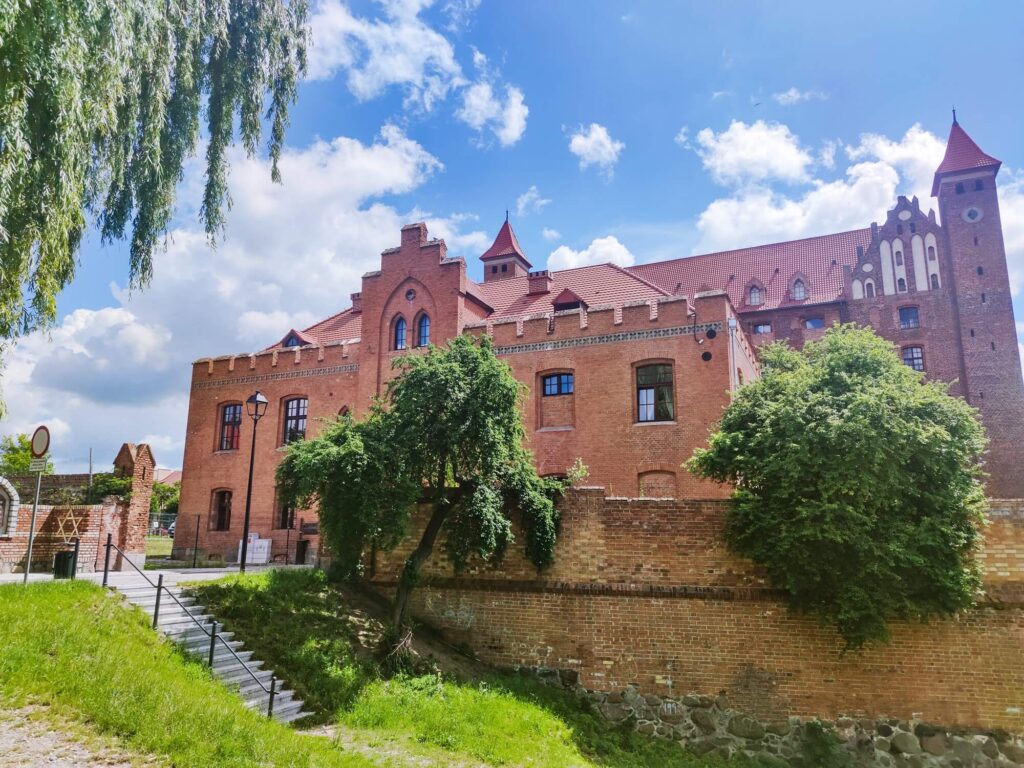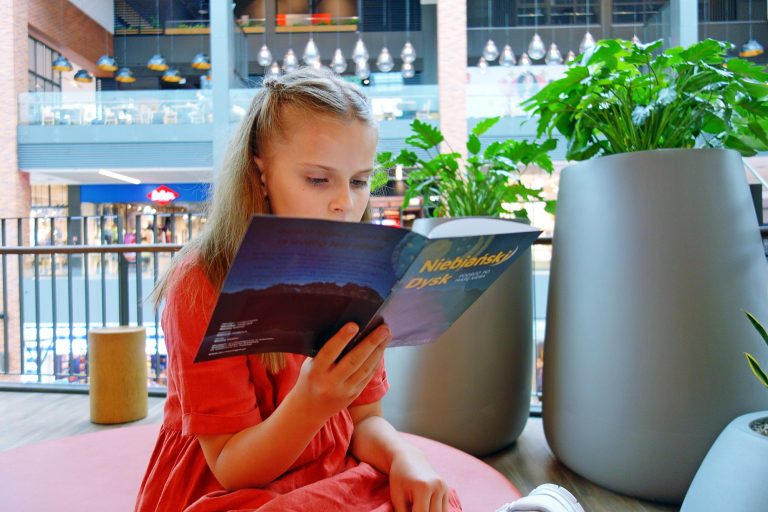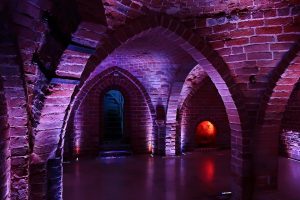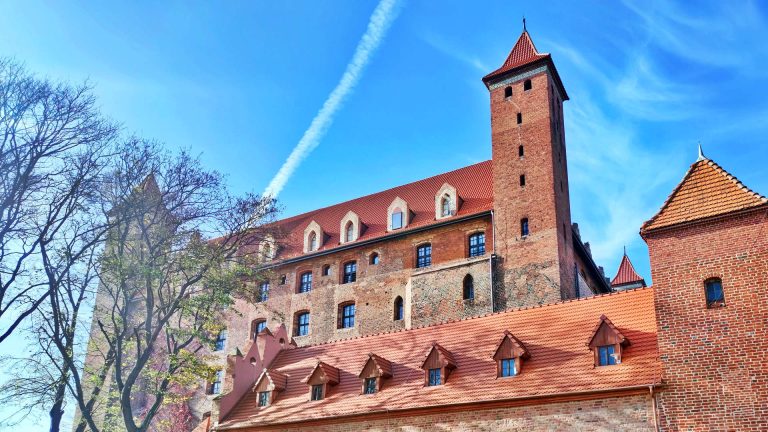Oddział w Gniewie

Siedzibą Oddziału w Gniewie jest Dom Bramny – tam kupuje się bilety do muzeum i pamiątki, tam też organizowane są wystawy czasowe. Wystawa stała “Gniew. Miasto na szlaku wielkiej historii” znajduje się na zamku.

Najlepiej na Pomorzu zachowana gotycka twierdza?
Nie tylko Malbork posiada swój krzyżacki zamek. Równie zachwycający i w pełni odrestaurowany znajduje się także w nadwiślanej miejscowości Gniew, leżącej w województwie pomorskim, w powiecie tczewskim. To właśnie tam mieści się oddział Muzeum Archeologicznego w Gdańsku.
The construction of the castle and its expansion
The construction of the castle in Gniew began in 1283. The supervision of the entire work was entrusted to Dietrich von Spira, the first commander of Gniew. The works lasted about 40 years.
Around 1290, a 6-meter-high external wall was erected, arranged in the shape of a quadrilateral. In three corners, square towers were added, and in the north-eastern corner a huge bergfried, i.e. ultimate defense tower. At that time, southern and northern residential wings were also built.
In the first half of the fourteenth century, the walls and turrets were raised, and the inner courtyard from the east and west sides was closed with two buildings.
The last stage of work was related to the adaptation of the stronghold into the permanent residence of the former Grand Master, Michał Kuchmeister. The chapel was then enlarged at the expense of guard rooms, and to the south of the conventual house (a type of a monastic house), a defensive outer bailey was established, surrounded by a wall with towers and two gate towers.
Castle in the hands of Poles
In 1466, under the Peace of Toruń, the castle passed into Polish hands and became the seat of starosts. In the second half of the 17th century, the starost of Gniew was Jan Sobieski, who, before becoming king, built a new baroque building for his wife, Maria Kazimiera, on the outer bailey.
The fortress changes hands
In 1772, Prussian troops entered Gniew and seized the castle. From then on, it performed military functions, and then served as a grain warehouse, which entailed the need to change the interior layout to a new division of the storeys.
In 1855, the walls of the outer bailey were partially demolished and the bergfried tower was demolished, replacing it with another, smaller one, similar to the other three corner towers.
Another reconstruction of the stronghold took place in the years 1856-1859 and was associated with the purpose of the building as a prison, commonly considered one of the heaviest in all of Prussia. The works consisted in removing the plasters, rebuilding the chapel's vault, dismantling the gdanisko (the tower standing outside the defensive walls) and carving new window openings.
Returned to Polish hands
In this condition, the castle was taken over by the Polish administration in 1920 and intended for the seat of the starosty, and then a military ammunition warehouse. During a fire in 1921, three wings and the roof of the stronghold were destroyed. During the occupation, it housed a paramilitary school for young people, and then a temporary prison for Poles.
Under the wings of the Museum
In 1968, the first revitalization works began at the castle. The Archaeological Museum in Gdańsk joined them in 1992. Only a year later, after the final removal of rubble and adaptation of the basement under the southern wing, the first exhibition was presented at the castle - "Gniew in the light of archaeological research in 1975-1985".
On January 27, 1995, after three years of efforts, by the decision of the then Gdańsk Voivode, Maciej Płażyński, the branch of the Museum at the Gniew castle was officially established. The new facility occupied the west wing of the castle and, in addition to conducting exhibition and scientific activities, it also became a partner of tournaments and historical events organized at the castle.
15 lipca 1998 roku otwarto multimedialną wystawę opowiadającą o bitwie pod Grunwaldem – „Grunwald 1410”, a w 2010 roku wystawę „Życie codzienne na średniowiecznym zamku”.
Otwórzcie bramę na oścież!
W 2022 r. Oddział w Gniewie zyskał nową siedzibę: Dom Bramny. Ten neogotycki budynek powstał w 1855 r. W XXI w. został odrestaurowany i zaadaptowany na potrzeby muzeum. To właśnie w Domu Bramnym zaczyna się zwiedzanie Oddziału w Gniewie. Tam kupuje się bilety i pamiątki, tam też organizowane są wystawy czasowe.
Idzie nowe
26 października 2022 r. w podniosłym i radosnym nastroju została otwarta nowa wystawa stała: „Gniew. Miasto na szlaku wielkiej historii”. Ekspozycja znajduje się w dwóch nowocześnie zaaranżowanych pomieszczeniach na zamku w Gniewie. Jak powiedziała Ewa Trawicka, dyrektor Muzeum Archeologicznego w Gdańsku, Gniew nareszcie doczekał się wystawy, która ukazuje historię miasta w pełni.
Oddział w Gniewie jest otwarty od wtorku do niedzieli (w poniedziałki zamknięty) w godzinach 10:00-17:00.
Zwiedzanie zamku z przewodnikiem odbywa się w następujących godzinach.
W okresie od 02.10.2023 r. do 29.04.2024 r., od wtorku do niedzieli: 10:30 | 11:30 | 12:30 | 13:30 | 14:30 | 15:30
W okresie od 06.05.2024 r. do 21.06.2024 r.:
- od wtorku do piątku – 10:30 | 11:30 | 12:30 | 13:30 | 14:30 | 15:30
- w sobotę i niedzielę – 10:00 | 11:00 | 12:00 | 12:30 | 13:00 | 14:00 | 15:00 | 16:00
Oprowadzanie w języku angielskim wymaga wcześniejszej rezerwacji telefonicznej: (+48) 58-535-35-29.
Dni świąteczne w 2024 roku
1 stycznia (Nowy Rok, poniedziałek) – nieczynne
2 stycznia (wtorek) – nieczynne
6 stycznia (Trzech Króli, sobota) – nieczynne
30 marca (Wielka Sobota) – czynne w godz. 10:00–15:00
31 marca (Wielkanoc, niedziela) – nieczynne
1 kwietnia (Wielkanoc, poniedziałek) – nieczynne
1 maja (Święto Pracy, środa) – czynne w godz. 10:00–17:00
3 maja (Święto Konstytucji 3 Maja, piątek) – czynne w godz. 10:00–17:00
19 maja (Zielone Świątki, niedziela) – czynne w godz. 10:00–17:00
30 maja (Boże Ciało, czwartek) – czynne w godz. 10:00–17:00
15 sierpnia (Święto Wojska Polskiego, Wniebowzięcie NMP, czwartek) – czynne w godz. 10:00–17:00
1 listopada (Wszystkich Świętych, piątek) – nieczynne
11 listopada (Narodowe Święto Niepodległości, poniedziałek) – czynne w godz. 10:00–17:00
24 grudnia (Wigilia, wtorek) – nieczynne
25 grudnia (Boże Narodzenie, środa) – nieczynne
26 grudnia (Boże Narodzenie, czwartek) – nieczynne
31 grudnia (Sylwester, wtorek) – czynne w godz. 10:00–15:00
- normalny – 25 zł
- ulgowy – 18 zł
- rodzinny dla maks. 5 osób (2 osoby dorosłe i 1–3 dzieci) – 60 zł
Muzeum wspiera akcję Dawcom w Darze – legitymacja Honorowego Dawcy Krwi uprawnia do zwiedzania ulgowego.
Obywatele Ukrainy mają zapewniony wstęp wolny.
W każdy wtorek wstęp na wystawy jest bezpłatny.
Zwiedzanie z przewodnikiem w języku angielskim: cena biletu wstępu + 80 zł. Wymaga wcześniejszej rezerwacji telefonicznej: (+48) 58-535-35-29. In English: ticket price + PLN 80, requires prior telephone reservation: (+48) 58-535-35-29.
Informacja turystyczna jest dostępna pod numerem tel. (+48) 734-155-230.
LEKCJE MUZEALNE / WARSZTATY
Oddział w Gniewie organizuje zajęcia edukacyjne dla przedszkoli i szkół podstawowych. Oferta jest opisana szczegółowo w zakładce EDUKACJA.
DISCOUNTS AND EXEMPTIONS FROM FEES are available upon presentation of relevant documents.
Concessions are available to:
- students of primary, lower and upper secondary schools, students of teacher training establishments and social service employees, students and people undergoing doctoral studies who are citizens of the European Union Member States,
- people over 65 years of age, pensioners, as well as disabled people together with their guardians, who are citizens of European Union Member States,
- teachers of primary, lower secondary, upper secondary and higher schools, teachers and tutors of educational and upbringing institutions, correctional facilities, shelters for minors and diagnostic and consultation centers operating in the Member States of the European Union,
- veterans.
Free tickets are available to:
- children up to seven years old,
- licensed guides, tour guides and teachers as guardians of organized groups,
- persons awarded the Order of the White Eagle or the Order of Merit of the Republic of Poland, the honorary badge "Zasłużony dla Kultury Polskiej" and persons awarded the honorary title "Zasłużony dla Kultury Narodowej",
- employees of museums entered in the State Register of Monuments and members of the Association of Polish Museologists, the International Council of Museums (ICOM), the International Council for the Protection of Monuments (ICOMOS),
- members of the Association of Polish Archaeologists, the Polish Historical Society, the Association of Art Historians,
- archaeologists, historians and art historians - employees of state universities and the Polish Academy of Sciences.
VISITOR REGULATIONS
Prosimy zapoznać się z Regulaminem zwiedzania Muzeum Archeologicznego w Gdańsku.

Wielkanocne godziny otwarcia

Ferie zimowe 2024 w Muzeum Archeologicznym w Gdańsku

Inne godziny otwarcia w dniu 16.01.2024

Świąteczno-noworoczne godziny otwarcia (2023/2024)

Krótsze godziny otwarcia w dniu 20.12.2023 r.

Godziny otwarcia w Narodowe Święto Niepodległości (11.11.2023)

Weekend Seniora z Kulturą – od 29 września do 1 października 2023 roku

21 i 22 września 2023 r. trzy oddziały Muzeum będą zamknięte

„Niebiański Dysk. Podróż po mapę nieba” – archeologiczna gra miejska
Oddział w Gniewie

Konkurs fotograficzny “A może jednak Gniew…”

W święto Bożego Ciała (08.06.2023) Oddział w Gniewie będzie otwarty
Other branches:

Spichlerz Błękitny Baranek
53 Chmielna st, Gdańsk 80-748

Romanesque Cellar
1 Dominikański sq, Gdańsk 80-844

Sopot „Stronghold”
63 Haffnera st, Sopot 81-715
Z powodu awarii oddział jest zamknięty od 13.04.2024 r. do odwołania.

Naturalists' House
25/26 Mariacka st, Gdańsk 80-833
